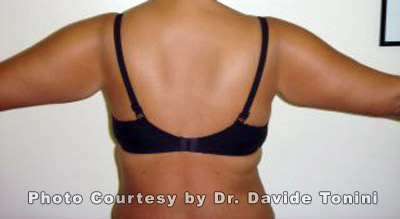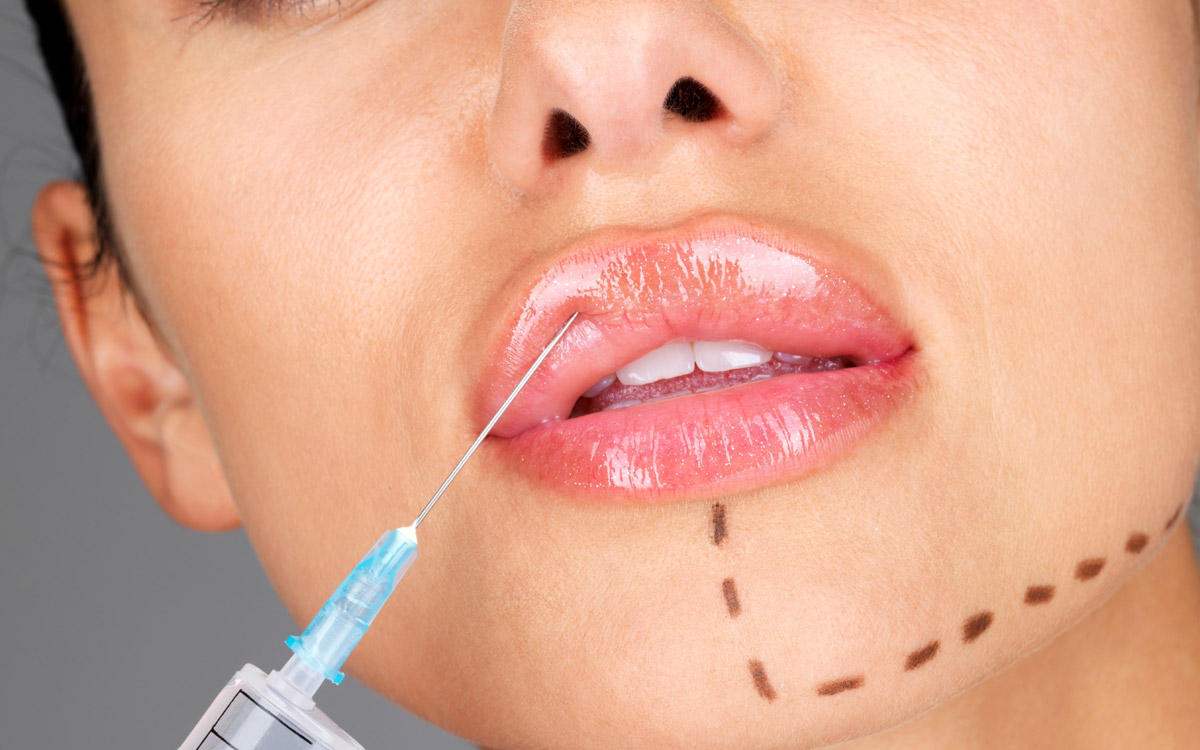- HOME
- EYE CENTRE -->
- CONTACT US
Aesthetic Surgery
- Home
- Aesthetic Surgery
-
Face and neck lift
Purpose of the Surgery
The passage of time, the exposure to stressful job conditions, the prolonged exposure to hostile environmental factors and bad daily life habits contribute to early skin ageing, as well as skin and deeper tissues laxity. The term lifting means the surgical lift of the relaxed tissues in order to restore a youthful appearance. In order to make the final result of a mini-lifting more durable, it is very important to redrape the skin tightening the facial muscles and to remove fat deposits.
The Surgery
Facelift consists in a small incision in front of the ear extending up into the hairline. Scars are almost invisible, as they are made within the hair. The short part of the scar made in front of the ear becomes undetectable within a few weeks. Facelift surgery can is performed under local anaesthesia with the support of a different degree of sedation (neuroleptoanalgesia) which is administered intravenously by the anaesthetist before and during the surgery. Sedation allows the patient not to feel any pain during the surgery.
-
After the Surgery
-
At the end of the facelift an elastic compression bandage is applied, in order to keep the affected area under a slight pressure; this procedure allows a progressive reduction of the oedema (swelling), that usually appears after the surgery, and which usually heals within two-three weeks, rarely combined with erythema (reddening) and bruises. Usually bruises tend to disappear within one week and they can be easily covered with some make up. Generally they appear in the area right below the eyes and in some areas to the side of the neck.
The bandage is changed two days after the surgery and, after a careful check up of the wounds, it is replaced by a lighter one. On the fourth or fifth day of the recovery period, the bandages are removed together with the sutures in front of the ear.
The remaining sutures behind the ear (the sutures may heal slowly because of their position and they require accurate medications and a good local hygiene) and on the hairline will be removed after one week. The complete normalisation of the appearance after a facelift can be reached within two weeks.
-
-
Details about the Surgery
-
Generally facelift fairly reduces the sensibility on the front edge of the ear and of the neck, which gradually recovers. After the surgery, two or three resting days are recommended. It would be better to plan one week off from work and social activities. It is possible to go back to sports activities after the third week.
Hair can be gently washed after the bandage has been removed, while discoloration and hair dyes can be done starting from one month after the surgery, when the healing process is already in an advanced phase.
Careful avoid the exposure to the sunlight and to potential heat sources in order not to stimulate the pigmentation of the residual scars on the front edge of the ear. Caution during shaving is recommended to men; during the post-operative period the use of an electric shavers may be preferable.
Use the arrows to browse the different treatments
-
-
-
-

-
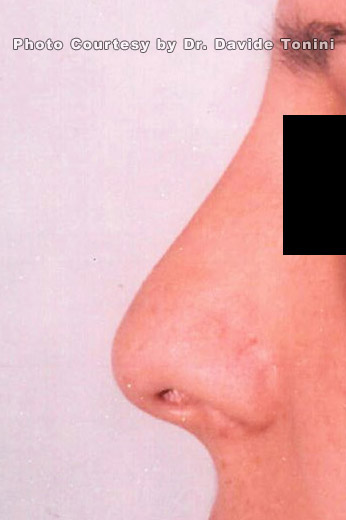
-

-
Rhinoplasty
Purpose of the Surgery
Rhinoplasty is nowadays one of the most popular plastic surgery procedures and it is considered as the ideal surgical approach within the aesthetic field, as it does not leave any scar, because the surgery operates within the pyramidalis nasi.
The purpose of the surgery is the achievement of a nose in harmony with the face thanks to the correction of the nose’s flaws (aesthetic rhinoplasty) and the restoring of the functions of the nose in case of respiratory impediment, such as nasal septum deviation or turbinates’ hypertrophy (rhinoseptoplasty).
Thanks to rhinoplasty, the surgeon modifies the osseo-cartilaginous nasal framework of the nose via an inside incision (except for the cases of reduction of too long or too wide nostrils, where it is necessary to do an incision on the nose, which will be hidden in between the natural folds at the base of the nostrils).
After the surgery, the nasal skin, which during the operation is completely separated from the nasal framework, will adapt to the new anatomical framework and it will not give absolutely the impression that the patient has had a plastic surgery. The correction of the tip of the nose, whose shape and dimension depend on the alar cartilages that constitutes it, is usually done when it is long, wide, crooked, sagging or bifid.
The Surgery
The surgery procedure consists in lifting the nasal skin (for this reason the procedure is called open rhinoplasty) thanks to small incisions on the edge of the nostrils, removing the part of cartilage in excess and reshaping the framework of the nose. If necessary, the surgery can continue with the correction of the dorsum. The nasal skin is separated from the bone framework thanks to small incisions inside the nose, the nasal hump is removed thanks to a very thin scalpel and, bringing closer the lateral bones, the lateral width is reduced.
Rhinoplasty is performed as an outpatient procedure, under general anaesthesia or local anaesthesia with sedation. This kind of plastic surgery is not painful. The only negative side is that for one or two days after the surgery the nostrils are closed by a specific nasal packing, so the patient has to breathe through the mouth.
A small plaster splint protects the newly corrected nose and it is removed after a few days. The oedema at the root and to the side of the nasal cavity can vary depending on the case. Swelling and bruises of the eyelids may appear in the first period of the post-operative phase, but they gradually disappear after a few days.
After the Surgery
It will take 6-12 months for the nose to heal completely. During this period the patient may notice a decrease of the sensitivity of the tip of the nose that will gradually recover its natural elasticity. The patient can go back to his or her daily life activities one week after the surgery, except for sports activities for he or she will have to wait one month.
Details about the Surgery
It is recommended to avoid the exposure to direct sunlight for at least 2 months; for this reason the use of a total block sunscreen is recommended.
Use the arrows to browse the different treatments
-
-

-

-

-
Blepharoplasty
Purpose of the Surgery
The purpose of an Eyelid Lift, or Blepharoplasty, is first of all the correction of the typical defects of the eyelids (excess of the skin of the upper eyelid, bags under the eyes, ptosis of the eyebrow) and also the removal of shadow areas and the valorisation of other ones, in order to give back brightness and verve to the eyes and, therefore, to the whole face. The surgery gives back a more relaxed and youthful look to the eyes.
During the pre-operative examination of the patient, the surgeon considers the local conditions and determines the kind of procedure that has to be performed, explaining which defects can be corrected by the surgery and which will remain unchanged; moreover, he decides whether it is suitable or not to correct the shape of the eyes and the gaze.
The Surgery
Blepharoplasty procedures, if carried out individually and not together with a more complex treatment to the face, can be performed in a facility authorised to perform outpatient surgeries, so that the patient can go back home the same day of the surgery.
The surgery is performed under local anaesthesia with the support of sedation which is administered intravenously by the anaesthetist before and during the surgery and that allows the patient not to feel any pain during the surgery.
After the Surgery
After the surgery a light bandage and cold compresses to alleviate the oedema are applied. The oedema usually disappears between the fifth and seventh day after the surgery. It is ideal to use some ice cubes in a cellophane bag to put on a clean handkerchief laid on the eyelids.
During the first days after the surgery, eyelid swelling (oedema) may appear, as well as more or less evident bruises and dyschromia, depending on the patient. In case of irritation of the conjunctiva, usually it is enough to instil one drop of eye-drop in each eye every two-three hours and/or use an ophthalmic cream. Sutures will be removed in the clinic after 3-4 days.
Details about the Surgery
It is recommended to take some days off from your daily life activities until the removal of the sutures. You will need to protect your eyes with dark sunglasses. It is advisable to resume sports activities after at least a couple of weeks. Avoid the exposure to direct sunlight for at least two months.Use the arrows to browse the different treatments
-
-

-
Otoplasty
Purpose of the Surgery
Otoplasty is a surgical procedure that aims at the correction of protruding ears, i.e. those cases where the external ears (pinnae) protrude from the sides of the head because of a deformity of the cartilage, the framework of the ear. Thanks to the surgery it is possible to reduce the dimensions of the ears, remodel their shape and angle or correct asymmetries that affect either the external ear or the shape and dimension of the helix or anthelix.
Otoplasty can be performed under local anaesthesia, simply making the external ear insensitive thanks to local injections or under local anaesthesia with sedation, i.e. administering drugs intravenously in order to calm the patient.
The Surgery
The surgery consists in a small incision made behind the ear that fades with time. After an otoplasty procedure it will be necessary to use a bandage that surrounds the head, in order to protect the ears for 2-3 days. After this period, the bandage will be replaced by a stripe for one week.
After the Surgery
The patient can take a shower just in case the bandage is protected by water, while he or she will have to wait the removal of the medication and sutures (after one week) to wash his or her hair. The scar will become unnoticeable within a short period of time.
The patient can resume light sports activities after about two weeks, while it is recommended to wait about one month to resume heavier ones.Use the arrows to browse the different treatments
-
-

-

-

-

-

-

-

-
Breast Augmentation
Purpose of the Surgery
In the last years Breast Augmentation has become a routine surgical procedure within plastic surgery and a lot of patients undergo it in order to improve their physical appearance. Therefore breast augmentation with breast implants is no more just a procedure in post-mastectomy breast reconstruction, but it is becoming more and more an aesthetic surgery that aims at the correction of a physical defect.
-
Breast implants
-
Breast implants used in breast augmentation are not standard, but they are available in a wide set, different in size, diameter and projection. Breast implants are different mainly because of their profile, which can be low or high (low profile/high profile). Low profile breast implants for breast augmentation are flatter, while high profile breast implants, particularly suitable in case of underdevelopment of the mammary gland, have an up-rounded shape.
The breast implant set is very wide and it is possible to choose the width, height and projection of the desired implant, so that the patient can have a customised surgery. Breast implants can be round or teardrop shaped.
The surgeon suggests her patients an innovative examination for a completely customised choice of breast implants. This new kind of examination is possible thanks to the implementation of the BioDynamicTM system: a new system used in support of the mammoplasty pre-operative examination that allows an utter customisation of breast implants and the possibility to try them on in a realistic way in order to have a clear idea of what will be the final result.
-
-
The Surgery
-
The surgery procedure of a breast augmentation consists in the implantation of the chosen breast implants in two different ways, that characterise three different surgical procedures: periareolar or submammary.
Submammary Procedure: the traditional procedure in a breast augmentation consists in a submammary incision, i.e. a 2-3 centimetre long incision performed right below the submammary fold: in this way the breast will naturally sag, hiding the scar of the incision.
Periareolar Procedure: periareolar procedure in breast augmentation consists in a border-line incision around the medial-half (inferior half) of the areola’s circumference.
Breast augmentation is performed under local anaesthesia with sedation, usually as an outpatient surgery. During the post-operative period it is recommended to avoid to make efforts with the arms for about three/four days. On the other hand the patient has to wear a medical support brassiere day and night for at least two/three weeks.
-
-
After the Surgery
-
Patients can resume their daily life activities right after the surgery, while it is recommended to wait two weeks before going back to sports activities. The same suggestions worth for the exposure to the sunlight, except for the area where the scar is situated, that requires 6 months to heal completely.
Use the arrows to browse the different treatments
-
-
-
Reduction Mammoplasty
Purpose of the Surgery
Reduction Mammoplasty is performed especially on young women whose breast has overdeveloped during puberty (especially in case of gigantomastia) or on over 40 year-old women that consider a voluminous and sagging breast an impairment of their psychophysical integrity that causes embarrassment in affective and social relationships.
The Surgery
The surgery consists in the removal of excess tissues (skin and subcutaneous tissues), transposing the nipple-areola complex (NAC) higher upon the breast hemisphere, and in remodelling the adjacent tissues.
Reduction mammoplasty procedure is performed under general anaesthesia, within a facility authorised to perform surgeries, and its post-operative phase is completely painless (sometimes patients may feel a burning sensation in the operated area because of the suture). Reduction mammoplasty requires 1-2 days of hospitalisation. Before the surgery, drawings and measurements are done on the standing patient, in order to have marks to follow during the surgical incisions, when the patient will be laid supine.
After the Surgery
Reduction mammoplasty leaves an inverted-T shaped scar, usually really well performed and not noticeable. Drainages, usually applied in the final phase of the surgery, are removed after one or two days. A support bandage is applied at the end of the surgery and it is removed 48 hours later, replaced by a medical support brassiere that has to be worn day and night for at least one month.
Sutures are removed in the clinic after a few days, to the utmost after one week, being aesthetic sutures. The patient resumes her daily life activities after two or three days, carefully avoiding traumas to the breast for at least fifteen days. 10-15 days after the surgery, breast starts to resume its normal shape, gradually subsiding, and its sensitivity, which was reduced during the post-operative period.Use the arrows to browse the different treatments
-
-
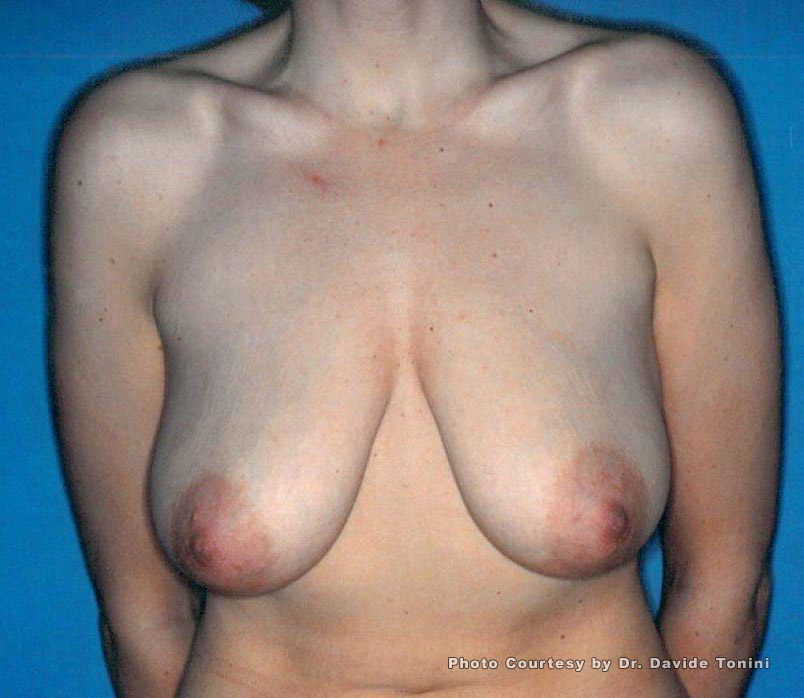
-
Mastopexy
Mastopexy is a surgical procedure that corrects “sagging breast”, usually caused by the excessive laxity of the tissues produced by restrictive diets, or breast that has lost volume, as in the typical case of post-partum ptosis, whose sudden onset causes in the patient not only an aesthetic problem, but most of all a psychological issue, due to the inability to accept this change in her physical appearance.
The ideal procedure to perform a mastopexy would be the one that allows the achievement of an harmonious shape, the increase of the projection of the upper breast, the transposition of the nipple-areola complex combined with the reduction of the scars’ visibility, fulfilling in the best way the patient’s satisfaction. The incisions of a mastopexy are comparable to the ones done in a reduction mammoplasty but less noticeable.
Mastopexy is performed as an outpatient surgery under local anaesthesia with sedation or under general anaesthesia, in order to guarantee an adequate protection during the operation with minimal side effects and no pain at all. In the post-operative period after a mammoplasty the patient requires a protective bandage that has to be worn day and night for at least three weeks. Results are noticeable right after about twenty days and scars tend to lighten after a few weeks.Use the arrows to browse the different treatments
-
Abdominoplasty
Purpose of the Surgery
Abdominoplasty procedure involves the removal of excess skin and fat from the middle and lower abdomen in order not much to lose weight, but rather to tighten the muscle and fascia of the abdominal wall and to improve the look of the prominent abdomen.
Diet and exercise alone are not enough to achieve this result because this condition is often combined with the separation of the abdominal muscles between them and the weakening of the abdominal wall.
The Surgery
The abdominoplasty operation consists in an incision made from hip to hip just above the pubic area. The scar is therefore horizontal and extends laterally depending on the quantity of skin that has to be removed. It can be easily hidden by a normal bikini. Usually the surgery is performed under general anaesthesia.
After the Surgery
Al termine dell'intervento è infine applicato un bendaggio compressivo modellante, che, quando viene rimosso, verrà sostituita da una guaina contenitiva da indossarsi per un periodo di 20-30 giorni. I punti di sutura vengono rimossi entro 10 giorni dall'intervento.
At the end of the surgery a contouring compression bandage is applied and, when removed, it is replaced with a compression girdle that has to be worn for 20-30 days. Sutures are removed within 10 days from the surgery. Initially, the patient may feel bruising and discomfort along the suture: caution in movements and walking is advisable. It is recommended to slip supine for at least two weeks. The patient can resume his or her daily life activities within two weeks, his or her work at the end of the recovery period, while he or she will have to wait at least a couple of months to resume sports activities.Use the arrows to browse the different treatments
Mini-Abdominoplasty
In case the abdominal flaw is delimited to the area under the navel and consists in a moderate excess of fat and skin, usually associated with an initial weakening of the abdomen muscles, the traditional abdominoplasty procedure turns out to be excessive, while liposuction will not lead to an efficient result.
The best surgical procedure is middle way: the mini-abdominoplasty, which is simpler than the complete abdominoplasty but more developed than liposuction. It involves a smaller scar and it does not interest the navel. Moreover, recovery is easier and faster.
The operation is performed under epidural anaesthesia or local anaesthesia with sedation, as an outpatient surgery, within a facility authorised to perform surgeries.
The mini-abdominoplasty surgery ends with the suture of the incision and the insertion of a small drainage in the incision, which is usually removed after 48 hours. A compression bandage will be then replaced with a supportive girdle, that as to be worn for at least three weeks.
After at least ten days, sutures are removed and the patient can resume his or her daily life activities.Use the arrows to browse the different treatments
-

-
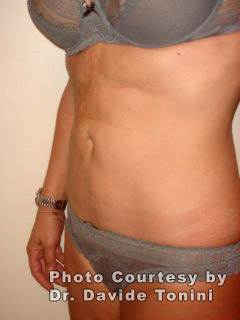
-

-

-

-

-

-
Liposuction, Pneumatic Assisted Liposculpture
Pneumatic Assisted Liposculpture is a new surgical technique that differs from the traditional lipoaspiration procedure because of the use of a versatile, micro-invasive and handy new product that, thanks to a contouring procedure, allows to remove unwanted deposits of adipose tissue, accumulated during years of bad food habits and sedentary life.
Not to mention the physiological hormonal storms and genetic causes that have a remarkable effect on the general clinic conditions.
Fat deposits that can be surgically corrected with a lipoaspiration are:
- submental area
- upper arms
- abdomen and suprapubic area
- flanks
- outer thighs (saddlebags)
- gluteal region
- inner thighs, knees
- legs, ankles, calves.
Liposuction procedure has to be carried out within a facility authorised to perform surgeries and it is done under local anaesthesia with sedation, when the area that has to be operated is minimal, or under general anaesthesia, when fat deposits are more extended.
During the post-operative period the patient has to wear a compression contouring garment. This garment must have elasticity and allow the skin to perfectly adapt to the new contour and the reduction of the bruises, that usually fade within 15-20 days. Sutures are removed after 7 days. The patient can carefully resume his or her daily life activities the day after the surgery.
If the amount of suctioned fat is considerable, the patient may feel tired: for this reason working activities have to be properly planned.Use the arrows to browse the different treatments
-
Thigh Lift
Thigh laxity may arise as a natural consequence of the physiological ageing after a considerable loss of weight. The main purpose of a thigh lift is to remove skin flaccidity, through the tightening and removal of the tissues in excess.
This kind of surgical procedure is performed without any significant suture from the aesthetic point of view and it is usually required by over 35-40 year-old patients and just occasionally, if the aesthetic flaw is caused by reasons of constitution, by younger patients.
Thigh lift is free from any complication, is performed as an outpatient procedure under local anaesthesia with sedation. After the surgery it is recommended to wear an elastic compression pantyhose for 20 days. The recovery is fast and complete. Post-operative side effects are minimal.Use the arrows to browse the different treatments
-
Gluteoplasty
Gluteoplasty (or Buttock Augmentation) is an innovative surgical approach within the wide range of body contouring procedures and it is performed in order to correct the so-called “flat buttock”. The medical procedure can be managed either as an overnight in-patient treatment or as a hospital outpatient treatment.
The surgical technique consists in the insertion of the buttock prosthesis through a midline incision over the tailbone. The surgery finishes with a continuous intracutaneous suture that will not leave any noticeable scar.
A local anaesthesia with sedation is the ideal technique for this kind of surgery, as it allows a fast recovery period and avoids the possible side effects of a general anaesthesia. Sutures are removed after 8-10 days.
The patient cannot sit down or sleep in the supine position for 20 days: this may entail the dislocation of the prosthesis. The best aesthetic result will be noticed after about 2 months from the surgery, when the normal post-operative swelling will fade away.Use the arrows to browse the different treatments
-
Lipofilling – Lipostructure
Lipostructure is the advanced technique of lipofilling that allows increasing the volume of some areas of the body using a person’s own fat as filler. The procedure consists in aspirating some fat from the donor area with very thin needles and processing it, in order to select a pure liquid fatty tissue that can be used more easily, and injecting it where needed.
The surgery is performed under local anaesthesia with a very thin needle, specific in order not to damage the fat. After this light operation, some discomforts may arise (local soreness, swelling, bruises) that usually fade away in a few days.Use the arrows to browse the different treatments
-
Micro-Follicular Hair Transplant
Micro-Follicular Hair Transplant represents without any doubt the most efficient procedure within the surgical treatments of baldness to treat androgenic alopecia: a complex problem that is very common and felt among men. In effect the 80% of men suffers from baldness during their life.
Patients that go to the surgeon to treat baldness or the decrease of density of the hair, have not only an aesthetic problem, but most of all they feel embarrassed and in some cases this may result in panic attacks that have serious consequences on their life and relationships.
The technique dates back to the ’60: for about thirty years the procedure has consisted in the transplantation of small circular portions of the scalp, each of them containing from 8 to 12 hair bulbs taken from the back of the head. These hair bulbs were then transplanted to the balding parts with a great result from the functional point of view, but aesthetically not satisfactory, as they led to a doll’s head-like appearance.
The Surgery
During the last years the surgical technique has developed and improved in order to achieve a more natural result: grafts are divided in individual hair follicles containing one or more follicular units (each containing maximum three or four hairs), together with the annexed pilosebaceous apparatus, that are transplanted to the balding part.
The number of hairs that it is possible to recover thanks to this technique varies a lot and it depends on:- - the number of hair bulbs contained in each donor graft
- - their phase or life cycle (anagen, catagen, telogen phase)
- - the patient’s psychophysical conditions
- - the number of planned sessions depending on the degree of hair loss.
Transplanted hair follicles are not subjected to the hormonal influences that cause hair loss and therefore they are considered permanent. The back of the head where hair follicles are taken, equal to 1,5 centimetres of width and variable in length, is shaved: after the hair follicles have been taken, donor area will be sutured with an intracutaneous closure that therefore will be invisible and hidden by the hair.
The recipient site is anaesthetised and the surgeon prepares the micro-holes where the follicular units have to be placed. One of the most delicate phase of this surgical procedure is without any doubt the work done by the nurses: they have to dissection the donor strips into individual grafts. This must be performed with extreme care under microscope and with the support of the transillumination. The operation is performed as an outpatient surgery under local anaesthesia.
After the Surgery
During the immediate post-operative phase, in addition to moderate swelling, small reddish dots may appear, but they usually become scabs and fall off spontaneously within a few days: it is important not to remove them because the risk is to remove the transplanted hair bulbs as well.
Sutures of the donor site will be removed after 10-12 days. It is recommended to avoid sports activities that involve excessive perspiration or that may cause traumas to the head for at least two weeks. The patient can resume his or her daily life and work activities after 2-3 days. It is recommended to avoid exposure to direct sunlight for at least 3 months from the surgery and until the complete fading of the surgical signs, as it may facilitate the development of small spots on the scalp.
Aesthetic results are noticeable from the third month, and by the sixth substantial new growth will be evident, fulfilling the patient’s expectation.Use the arrows to browse the different treatments
-
Fillers with Hyaluronic Acid
The natural ageing process of our tissues with the passage of time brings to the progressive relaxation of the skin, the hypotonia of the muscle fasciae and the reduction of moisturizing. All these factors cause the growth of face irregularities and wrinkles. Hyaluronic acid injections help to rejuvenate the facial appearance diminishing irregularities and wrinkles and filling hollows in the face.
Hyaluronic acid is a natural substance contained in our organism, that gradually decrease with the passage of time and that therefore has to be restored. It is injected in the face, particularly in the area of nasolabial folds, at the lips edge, to correct the so-called “barcode wrinkles” (the vertical wrinkles above the upper lip) and to fill the cheeks, cheekbone, mandibular arch, etc.
The injection is performed with a very thin needle within the depth of the skin. Using a very thin needle, the surgeon will inject it under the surface of the skin in order to treat thinner irregularities, or more in depth for the treatment of deeper wrinkles. The treatment is completely painless, also thanks to the use of some anaesthetic added to the hyaluronic acid. Results are noticeable right after the injection, but tend to improve within the 4-5 days after the treatment.
Results last about 4-6 months, even if this period of time is very variable.Use the arrows to browse the different treatments
-
Lips fillers with Hyaluronic Acid
With the passage of time, lips tend to lose their volume and appear thinner and less defined. Hyaluronic acid is the only product that can be used to increase lips volume. Thanks to hyaluronic acid lips injections it is possible to improve their definition, shape and volume.
Lips volume increase is almost painless thanks to a local anaesthetic added to the hyaluronic acid and thanks to the use of an anaesthetic cream. In this case as well the treatment lasts for 4-6 months.Use the arrows to browse the different treatments
Fillers with Volume-Increasing Hyaluronic Acid (Medical Lift)
With the passage of time the gradual loss of frameworks and tissues’ volume occurs. The Volume-Increasing Hyaluronic Acid treatment is used to recover a loss of volume and to give back a fine contour to cheekbones and chin; it causes a real lift of the sagging or emptied frameworks thanks to a lift effect.
The product uses the same moisturising properties of hyaluronic acid, but in a homogeneous and long lasting formulation that remodels the shape and contour of the face. Volume-Increasing Hyaluronic Acid is injected with very thin needles more deeply than hyaluronic acid used as a filler, so results last more (10-12 months). This treatment leads to a very natural aesthetic result as well, it is performed as an outpatient procedure and the patient can resume immediately his or her daily life activities.Use the arrows to browse the different treatments
Botulinum Toxin
The common use of Botulinum Toxin has demonstrated that injections are safe and efficient in the rejuvenation of the upper region of the face to attenuate wrinkles on the forehead and on the periorbital area. Drug is injected following a specific sequence of injections and reduces or temporarily removes wrinkles of the upper region of the face (forehead, root of the nose and crow’s-feet).
Unlike hyaluronic acid, which is essentially a filler, botulinum toxin works on the decrease of the contraction of the muscles that cause wrinkles and that for 4-6 months work less, developing less wrinkles. The treatment is painless and it is performed as an outpatient procedure.
Wrinkles fade after 4-5 days from the injection and the patient can immediately resume his or her daily life activities. This treatment is suitable also in case of excessive sweating of hands and underarms.Use the arrows to browse the different treatments
Chemical peels
This treatment removes the most exterior skin layers and determines a better smoothness and brightness of the face. It is suitable to treat acne, skin spots and photoageing as well. Surgeon will choose the most suitable treatment depending on the age and kind of skin of the patient and on the aesthetic problem that has to be improved (dark skin spots, superficial wrinkles, photoageing and scars caused by acne). The treatment is performed as an outpatient procedure and the recovery period varies from a few hours to some days, depending on the kind of peel.
Use the arrows to browse the different treatments
Skin Bio-Revitalization
This treatment improves the moisturising, tone and elasticity of the skin on the face, cleavage, hands and other parts of the body. It consists in the injection of a mix of hyaluronic acid-based substances combined with other skin nutrients, such as amino acids, vitamins, mineral salts, etc. with very thin needles. Skin Bio-Revitalization is performed as an outpatient procedure, it has to be repeated one/two times per month and it allows the patient to resume immediately his or her social activities.
Use the arrows to browse the different treatments
-

Face aesthetic surgery
Face and neck lift
-

Nose aesthetic surgery
Rhinoplasty
-

Eyelids aesthetic surgery
Blepharoplasty
-

Ears aesthetic surgery
Otoplasty
-

Breast aesthetic surgery
Breast augmentation
-

Breast aesthetic surgery
Reduction mammoplasty

Breast aesthetic surgery
Mastopexi
-

Abdomen aesthetic surgery
Abdominoplasty
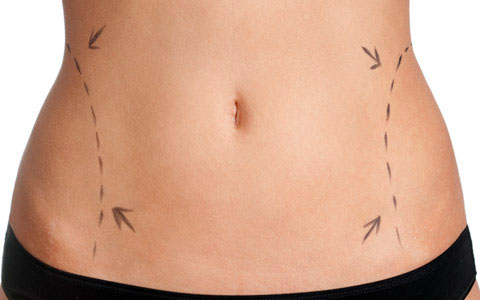
Abdomen aesthetic surgery
Mini-abdominoplasty

Body aesthetic surgery
Liposuction – Liposculpture

Body aesthetic surgery
Thigh lift

Body aesthetic surgery
Gluteoplasty

Body aesthetic surgery
Lipofilling – Lipostructure

Baldness surgery
Micro-Follicular Hair Transplant

Aesthetic medicine
Fillers with hyaluronic acid

Aesthetic medicine
Lips Fillers with Hyaluronic Acid

Aesthetic medicine
Fillers with Volume-Increasing Hyaluronic Acid

Aesthetic medicine
Botulinum toxin

Aesthetic medicine
Chemical peels

Aesthetic medicine
Skin Bio-Revitalization

Aesthetic medicine
Spider Veins and Varicose Veins Treatment (legs)
Day Hospital Borgo Wührer
-
-
Borgo Pietro Wührer, 129
-
25123 - BRESCIA
-
-
VAT VAT, C.F., Reg. Imp. BS 02450890989<br> REA 450965 - Cap. Soc. 100.000 € i.v.
Day Hospital BW - Health Director Dr. Paolo Scaroni - Copyright © 2013 - Powered by VegaFX
-
-
-
-
-
-
-
-











